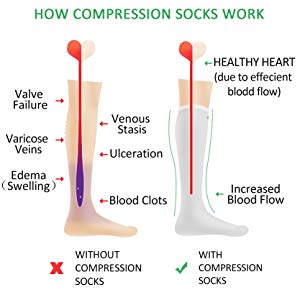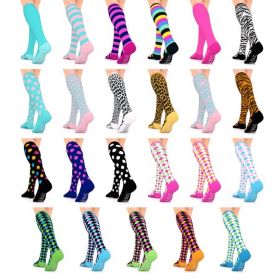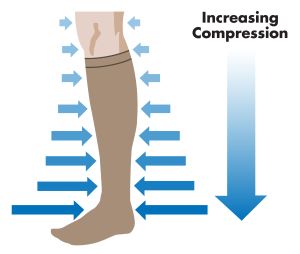Have you ever taken a long-haul flight and been surprised to find your ankles swollen to twice their normal size by the time you get off the place? Or perhaps you’ve heard about Deep Vein Thrombosis (DVT) and blood clots on long flights and are wondering how to prevent them? (ComproGear Best compression socks for flying) can help.
What is DVT?
DVT is a condition in which blood clots form in a vein deep in your leg. The longer your travel time, the higher your chances of experiencing DVT. This blood clot can take a toll on your circulation, leading to swelling and pain. In more serious situations, the blood clot can travel to your lungs.
You can prevent DVT on long flights by wearing the right pair of compression socks. Quality compression socks will promote blood circulation from the legs back to the heart. In turn, you’ll experience less swelling of the legs, feet, and ankles, as well as a lowered risk for blood clot formation. Remember to pack your pair of compression socks next time you have to fly!
How Do Compression Socks for Flying Work?

Compression socks apply steady pressure to your legs which promotes good blood circulation. The pressure from the compression socks relaxes your arteries, preventing your legs from feeling tired. Dr. Velimir Petkov, medical director at Premier Podiatry in Clifton, New Jersey, recommends putting on your socks before leaving for the airport, as its is tough to pull them on once you’re sitting in the plane.
How to Wear Compression Socks

It’s always a good idea to try out your compression socks before you fly. If your socks feel too tight, you may have the incorrect size. Properly fitted compression socks will make your flight more comfortable. Since compression socks have a tighter fit than normal socks, here’s a trick to get them on with ease:
- Grab the toe of the sock, folding the rest of the sock inside out over the toe.
- Push your foot into the toe area, turning the socks right side out as you pull your socks over the leg.
Does Wearing Compression Socks While Flying Help?
It is recommended to wear compression socks or compression stockings during your flight if you are worried about clotting blood. Pregnant women may also benefit from a pair of compression socks while traveling since both pregnancy and long flights can each contribute to swelling of the ankles. Anyone with a history of blood clots or swelling stands to gain a bit of comfort by wearing their compression socks during the flight.

Cochrane Library has completed a review of several trials which show high-quality evidence that wearing compression socks reduces the incidence of DVT on flights. They determined that there is possibility edema may also be reduced in airline passengers through the use of compression stockings.
This exciting evidence is reason enough to justify pulling on your compression socks before you head to the airport. Though you don’t have control over everything while you travel, you do have the means to take care of your circulatory health, making your trip more comfortable in the process.
Uniform Compression or Graduated Compression Socks?
Uniform Compression Socks
The most commonly worn compression socks for flying are uniform compression socks. Uniform compression socks provide the same amount of pressure along the entire length of the sock. The pressure applied to the leg from a uniform compression sock is often low- to mid-range, usually 20-30mmHg.
This is a low enough level of compression to be well tolerated by most people but high enough to effectively increase blood circulation. You can purchase a pair of non-graduated compression socks through ComproGear without a prescription.
Graduated Compression Socks
Graduated compression socks will be tight around the ankle, graduating to a lower pressure towards the calf of the leg. Depending on your medical condition, your doctor may recommend graduated compression socks. For people with chronic venous diseases or who regularly suffer from edema, wearing graduated compression socks while flying will be preferable to wearing a uniform compression sock.
As they often apply a high level of pressure to the leg, graduated compression socks are not always well-tolerated by wearers. Be sure to wear your graduated compression socks before you travel by plane so you can become used to the sensation of compression. If your socks feel uncomfortable, touch base with your doctor to discuss your options.
Levels of Compression
Compression socks are available in varying degrees of compression. The compression applied by your sock is measured in millimeters of mercury (mmHg). Below is a breakdown of the pressure options you will have:
- Mild: 8-15 mmHg
- Moderate: 15-20 mmHg
- Firm: 20-30 mmHg
- Extra-firm: 30-40 mmHg
Depending on how much compression your condition needs, you can choose between mild to extra-firm socks. If you are unsure which compression level is best for you, consult with your doctor or pharmacist.
Are Compression Socks Safe for Everyone?
While it is highly recommended to wear compression socks when flying, there are circumstances where compression socks should be avoided.
Recent Injuries
A new wound, open cut or skin infection on your leg should not be covered with a compression sock. Wearing compression socks over the injury may cause pain or further damage fragile skin.
Severe Peripheral Arterial Disease
If you have a severe peripheral arterial disease, wearing compression socks during your flight may decrease the circulation in your extremities rather than improving it. With a diagnosis such as this, gathering more information from your doctor is important prior to using compression socks.
Diabetic Neuropathy
Damage to nerves in the feet commonly occurs in people with diabetes. This diabetic neuropathy precludes you from wearing compression socks for flying. If you have this condition, wear compression socks only under the recommendation of a doctor.
Popular Articles on ComproGear
Rose Toy Information on the Silent Red Version
Benefits of Compression Socks While Traveling
Blood Clot Prevention

DVT is a common condition in people who fly often. The condition is seen more amongst frequent fliers who spend over five hours traveling at a time.
Though DVT is more uncomfortable than it is dangerous, should the clots formed in the legs travel to the heart or lungs, the situation can become life-threatening. Wearing compression socks is a safeguard against this; improved blood flow from pressure socks reduces the risk of clotting.
As a rule, prevention is always better than a reactionary response. Ease your legs, take care of your circulation and stay healthy with a quality pair of compression socks for flying.
Other tips to reduce your risk of DVT on long flights
Here are other activities that act as a supplement to your compression socks when flying:
- Drink plenty of water.
- Avoid alcohol.
- Walk around, stand and stretch often.
- Flex your ankles while seated. A good rule of thumb is to flex them a few times every 30 minutes.
- Just for added comfort, bring yourself a pillow and relax. It won’t prevent DVT, but it can prevent stress. We wish you a safe and easy flight.
Less Swelling

Do your legs, feet or ankles tend to swell following a long-haul flight? Putting on compression socks can prevent or reduce the swelling. The pressure these socks apply promotes blood flow, reducing the chance of developing swelling.
To keep down swelling, you may also want to take in more fluid and avoid salty food. Dehydration is common among travellers and is often associated with leg swelling. So put on those compression socks and pick up a water bottle!
Warmer Legs and Feet
Your compression socks can help keep your blood flowing as you sit for hours on the plane. That improved circulation keeps your extremities warmer. Having the extra layer of a knee-high compression sock can keep you cozy on a plane with poor temperature control, too.
Complements Your Sense of Style

Are you choosy when it comes to the socks you wear? Do you prefer plain socks or stylish socks?
Today there are many style and color options to consider. It is possible to find a pair of compression socks that you’ll be comfortable wearing even when you’re not traveling.
To get the most out of your compression socks, pick a pair that is consistent with your daily style.
What to Look for In a Good Compression Sock
Now that you understand the benefits of wearing compression socks while flying, here are a few features to keep in mind when shopping:
Compression Level

Do you remember the four levels of compression we discussed earlier? Choosing the correct level of pressure for yourself is important for a comfortable fit. Socks with a higher mmHg pressure rating will offer more compression, and socks with a lower rating offer less compression. If you do not have a serious medical condition, a 20-30mmHg compression sock will do the trick for travel.
If you have a medical diagnosis that may adversely affect your nerves or the circulation in your extremities, discuss with your doctor which pressure rating is safe for you.
Size
Your socks will only be beneficial if they are the correct size. A sock that is too small will end up causing discomfort as a result of too much pressure. On the other hand, socks that are too large will result in little to no pressure on your legs. Many brands offer sizes ranging from extra-small to extra-large. Usually a size medium sock will be the best option for men with a shoe size of 5-9.5 or for women with a shoe size of 6-10. A large sock is ideal for customers who wear a men’s shoe size 9-12 or a women’s shoe 10-13.
Check sizing carefully while shopping online and be sure to order from platforms that have a sound return policy, just in case. If you have questions about how compression sock sizing works, you can connect with ComproGear.
Material
ComproGear’s compression socks are made with high-quality materials, providing you with a durable product. The combination of nylon and elastane fabric lasts longer, holding its shape better than those designed with low-quality materials. Fabric for compression socks must guarantee flexibility, moisture-wicking, effective pressure application and breathability. For maximum comfort, only buy compression socks designed from quality materials.
Height
Compression socks come in a range of height options. You can choose from thigh-high, knee-high or ankle compression socks. For travel, knee-high compression socks are the most popular. Note that the higher the socks go up your leg, the more compression action you will receive.
Affordability
While some compression socks are costly, it is possible to find quality compression socks at an affordable price. Find the balance between over-priced and cheap. It is always better to purchase a good quality compression sock with durable fabric than to save money up front on a cheap product. Cheap socks can become expensive when you have to start replacing them all the time. Don’t forget to ask if the seller guarantees your money back, just in case you are not happy with your purchase.
Gender
As you are looking for the correct size, be sure to check if the compression sock brand is offering men’s and women’s sizes separately. A men’s size medium will be very different than a women’s size medium. If you are shopping with a brand that offers unisex compression socks, double check their sizing chart to ensure you’ve chosen the correct size based off of your shoe size.
Where’s Your Pair?
Putting on a good pair of compression socks before your flight is the first step towards a great travel experience. Keep your legs pain-free and prevent swelling with compression socks that boost blood flow, reducing the risk of blood clots.
This page last updated December 15, 2022
